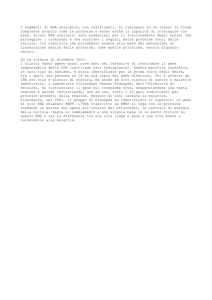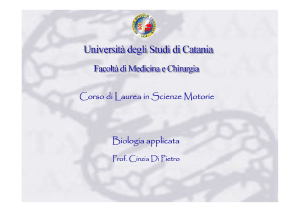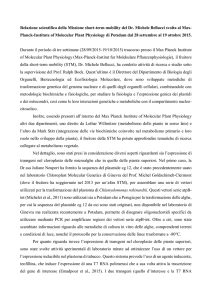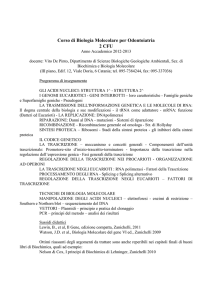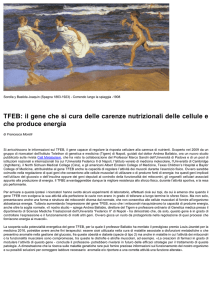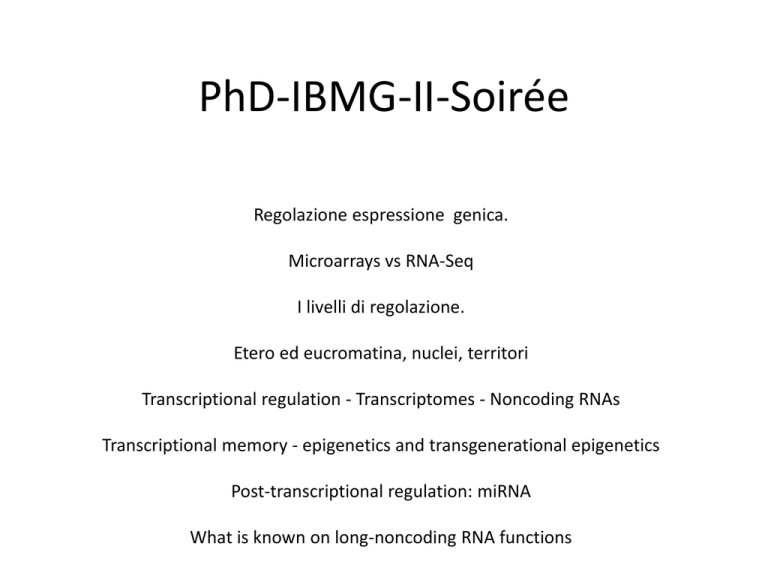
PhD-IBMG-II-Soirée
Regolazione espressione genica.
Microarrays vs RNA-Seq
I livelli di regolazione.
Etero ed eucromatina, nuclei, territori
Transcriptional regulation - Transcriptomes - Noncoding RNAs
Transcriptional memory - epigenetics and transgenerational epigenetics
Post-transcriptional regulation: miRNA
What is known on long-noncoding RNA functions
This is one of the millions cartoons representing DNA and figuring
genetics and molecular biology in the web.
Is that realistic in 2K ?
Does nacked DNA bring complete information ?
Proteins in this cartoon
are just examples
ENS LYON - Publications / Chromatin Dynamics and
DNA Repairwww.ens-lyon.fr
Chromatin Workshop projects.h-its.org
Chromatin carries the information. It is
composed of DNA, variously modified histone
proteins, DNA binding factors, enzymes, other
proteins and noncoding RNAs.
DNA
Histones and their modifications and variants
Enzymes
Transcription Factors
Other proteins
ncRNAs
DNA sequence is «genetic» since it is replicated and transmitted
without variations
Other things listed above represent «epi-genetic» information.
The term «Epigenetic» indicates an information that can be mitotically
inherited, but not linked to DNA sequence itself.
There is (erroneous) tendency to use it for all functional modifications
to chromatin, even when not inheritable. Just to know...
Valutazione dell’espressione geica differenziale
L’analisi del DNA e dell’RNA è basata sulla proprietà degli acidi nucleici della
ibridazione molecolare
secondo le regole di appaiamento di Watson-Crick
5’ – gttacctggagtagagacat – 3’
5’-atgtctctactccaggtaac -3’
Nei metodi di analisi classici, validi per singoli geni, il DNA frammentato o l’RNA
estratto da un tessuto vengono separati sulla base della dimensione molecolare
mediante elettroforesi su gel di agarosio
Dopo la separazione, il materiale è trasferito su un filtro (blot) e quindi le molecole
cercate vengono identificate perchè in grado di ibridare (ovvero legare) una sonda
costituita da un frammento di DNA complementare, marcata con un sistema che ne
consente la rivelazione (radioisotopi, fluorocromi).
Il riconoscimento qualitativo avviene sulla base della dimesnione molecolare dei
frammenti positivi
La misura semi-quantitativa è effettuata valutando l’intensità dell’ibridazione
Un’alternativa più moderna è la PCR (DNA) o RT-PCR (RNA)
Denaturing
Northern blot measures mRNA that is present in tissues or cell lines.
Evaluation is based on
1) hybridization signal;
2) size of the reactive mRNA species;
3) semiquantitative evaluation.
Probe finds its complementary
Labelled probe molecules
Different RNA molecules attached to filter
Filter
La tecnica di ibridazione su fase solida permette di misurare molti RNA
contemporaneamente – I microarrays a DNA
Sonde complementari
a diversi geni vengono
depositate su un filtro
L’RNA viene estratto
dalle cellule
Sonda A
Sonda B
RNA A
RNA B
Sonda C
ecc …
RNA C
ecc …
…e ibridizzati alle
sonde sul filtro
appositamente retrotrascritti
e marcati con fluorocromi
Risultato valutato come
intensità di fluorescenza
L’RNA viene estratto
dalle cellule
Gene A: SI
RNA A
RNA B
Gene B: NO
Gene X: molto!
RNA C
ecc …
…e ibridizzati alle
sonde sul filtro
appositamente marcati con RT
The complex probe, i.e.
labeled RNA (or cDNA) from
the biological sample
n1
n2
n3
n4
n5
n6
a section of a oligonucleotide microarray at row “n”
n……
How a spotted microarrays hybridized with two-colors probes looks like
under fluorescence microscope.
This is a low-density array,
just 1,600 probes / cmq
1 cm
Today up to >60,000
Illumina 12xWhole Human Genome Beadarrays
fluorescence quantitated
Laser source
Il DNA microarray viene sottoposto a scansione con un laser:
per ogni spot, viene quantificata la fluorescenza nel canale
appropriato.
La fluorescenza sarà proporzionale (entro un certo campo) alla
quantità di quello specifico RNA (complementare alla sonda in
quella posizione) presente nel campione.
How an Affychip is used
Single-color amicroarray
Dual-color labeling / Comparative hybridization
Double-color microarray
Cellule sane
Estrazione di RNA,
e marcatura con 2
diversi fluorocromi
Ibridazione
Cellule cancerose
The read-out of a microarray experiment for analysis of gene expression
Primary read out is a table of Fluorescence intensities
Gene name
Probe ID
Fluorescence
Normalized
__________________________________________________________
ABCD
Tor123456
346.78
1
CDH1
Tor123457
111.23
0.324
HRAS
Tor123458
222.46
0.648
TFF1
Tor123459
11.12
0.032
…..
.....
.....
(continues for N lines, from few hundreds up to 50-60,000 for genome-wide microarrays)
Bioinformatics, Statistics !
Secondary read-out is a comparative expression analysis
In the case of double-color assay:
For each gene (probe) the ratio between red and green fluorescence is measured.
This is called «ratio» and is usually expressed as a Log in base 2 (Log2ratio)
In the case of single-color assay, each gene (probe) is associated to a Normalized
value, i.e. the ratio of his normalized fluorescence to a standard reference gene(s).
Diversi campioni analizzati
Sonde (geni)
Nome vetrino
GEP_TAB2_25148 GEP_TAB2_25148 GEP_TAB2_25148 GEP_TAB2_25148 GEP_TAB2_25148 GEP_TAB2_25148 GEP_TAB2_25148 GEP_TAB2_25148 GEP_TAB2_25148 GEP_TAB2_25148 GEP_TAB2_25148 GEP_TAB2_25148
5037705_S01_GE2 5037705_S01_GE2 5036994_S01_GE2 5036994_S01_GE2 5036994_S01_GE2 5036994_S01_GE2 5037705_S01_GE2 5037705_S01_GE2 5036994_S01_GE2 5036994_S01_GE2 5036994_S01_GE2 5036994_S01_GE2
v5_95_Feb07_2_ v5_95_Feb07_2_ v5_95_Feb07_2_ v5_95_Feb07_2_ v5_95_Feb07_2_ v5_95_Feb07_2_ v5_95_Feb07_2_ v5_95_Feb07_2_ v5_95_Feb07_2_ v5_95_Feb07_2_ v5_95_Feb07_2_ v5_95_Feb07_2_
NO_Spikein_1_3 NO_Spikein_1_4 NO_Spikein_1_1 NO_Spikein_1_2 NO_Spikein_1_3 NO_Spikein_1_4 NO_Spikein_1_3 NO_Spikein_1_4 NO_Spikein_1_1 NO_Spikein_1_2 NO_Spikein_1_3 NO_Spikein_1_4
Numero vetrino
1
2
3
4
5
6
1
2
3
4
5
6
Colore
Red
Red
Red
Red
Red
Red
Green
Green
Green
Green
Green
Green
Stimolo
Tamoxifen
Tamoxifen
Untreated
Untreated
Estrogen
Estrogen
Tamoxifen
Tamoxifen
Untreated
Untreated
Estrogen
Estrogen
Trattamento
siCtrl
siTab2
siCtrl
siTab2
siCtrl
siTab2
siTab2
siCtrl
siTab2
siCtrl
siTab2
siCtrl
ProbeName
Gene Name
GEP_TAB2_25148 GEP_TAB2_25148 GEP_TAB2_25148 GEP_TAB2_25148 GEP_TAB2_25148 GEP_TAB2_25148 GEP_TAB2_25148 GEP_TAB2_25148 GEP_TAB2_25148 GEP_TAB2_25148 GEP_TAB2_25148 GEP_TAB2_25148
5037705_S01_GE2 5037705_S01_GE2 5036994_S01_GE2 5036994_S01_GE2 5036994_S01_GE2 5036994_S01_GE2 5037705_S01_GE2 5037705_S01_GE2 5036994_S01_GE2 5036994_S01_GE2 5036994_S01_GE2 5036994_S01_GE2
v5_95_Feb07_2_ v5_95_Feb07_2_ v5_95_Feb07_2_ v5_95_Feb07_2_ v5_95_Feb07_2_ v5_95_Feb07_2_ v5_95_Feb07_2_ v5_95_Feb07_2_ v5_95_Feb07_2_ v5_95_Feb07_2_ v5_95_Feb07_2_ v5_95_Feb07_2_
NO_Spikein_1_3 NO_Spikein_1_4 NO_Spikein_1_1 NO_Spikein_1_2 NO_Spikein_1_3 NO_Spikein_1_4 NO_Spikein_1_3 NO_Spikein_1_4 NO_Spikein_1_1 NO_Spikein_1_2 NO_Spikein_1_3 NO_Spikein_1_4
A_24_P478940
THC2668815
1592.824
997.1755
873.5041
607.8645
6829.532
5040.509
937.3201
1259.797
590.8834
642.9285
4210.666
5307.477
A_32_P38153
AK057709
1014.571
872.695
284.9987
256.1089
2096.175
2135.351
888.3797
1007.321
359.0979
268.0768
2749.321
2277.641
A_32_P49199
PGR
367.4936
431.2933
269.8744
268.6231
1955.63
1716.041
451.8824
339.7921
353.0977
251.629
2050.603
1702.065
A_23_P216225
EGR3
188.7889
117.2561
137.3518
95.94292
849.5961
378.4002
117.6472
166.3025
104.9777
127.9327
439.5834
667.7256
A_23_P73526
CITED1
256.0494
242.8608
100.6554
106.6672
586.6913
574.1368
239.8019
218.5055
122.4987
106.5085
570.5793
502.1365
A_23_P138938
PGR
202.7657
223.1904
166.2498
178.8664
836.921
950.6731
279.9407
197.2315
201.9929
154.4607
911.349
842.6516
A_23_P58407
UGT2B15
290.318
392.5214
159.4434
257.2121
755.6996
1108.057
421.2808
287.7875
276.8222
171.0651
1070.959
898.7676
A_23_P329768
GREB1
387.7765
397.7517
458.2526
438.8445
2063.436
1733.951
792.4646
795.0189
1399.793
1415.548
5009.719
6896.316
A_24_P17691
UGT2B17
225.9956
308.0241
155.5428
244.09
725.6027
934.7345
257.7644
204.1438
185.0093
143.4956
676.1984
573.0021
A_23_P69699
NPY1R
1255.263
1511.697
1073.773
1224.392
4469.823
4513.5
2907.967
2214.892
2590.699
2207.618
10689.16
9776.069
A_23_P202245
RET
1163.705
693.7436
614.1019
302.3615
2485.864
1702.553
696.5159
891.0366
319.0103
493.6255
1659.763
2235.899
A_32_P57877
CD365380
143.9107
149.4294
125.7661
143.0269
922.993
157.3608
157.2323
120.7246
148.6814
135.7534
609.369
151.409
A_23_P353614
C8orf46
117.3481
130.8704
124.6863
124.9572
468.4099
442.0125
123.2606
126.1182
131.7437
110.9967
472.9365
492.9662
A_23_P162579
HSPB8
3419.048
5547.424
1683.745
2566.708
6719.538
8617.95
5334.391
3374.663
2706.644
1632.549
8554.665
6753.329
A_24_P520201
THC2553558
114.9983
107.5519
114.1133
120.1143
796.6127
114.9806
122.9388
114.0368
121.6015
115.0924
508.4736
126.1093
A_23_P43157
MYBL1
1035.348
538.7504
1012.306
501.9906
3764.83
2334.458
568.0601
881.6594
534.3326
762.8434
1735.96
3246.104
A_23_P202448
CXCL12
679.2454
719.6995
560.4945
597.2649
2245.093
2037.724
681.292
647.324
618.933
510.4181
2004.935
1930.882
A_23_P168351
HEY2
222.4111
362.0376
151.4344
228.0122
550.1723
888.4076
425.047
302.0049
289.2479
176.576
943.4017
694.3075
A_23_P352535
PPP1R16B
257.9374
228.1916
253.6183
312.2321
1657.462
245.7492
217.1166
165.9701
186.6542
229.238
1192.102
171.7058
A_24_P100228
XBP1
13673.57
13781.52
10014.85
10653.04
36387.21
31597.26
14860.69
15023.41
9912.898
11257.68
30889.16
42537.33
A_24_P403417
PTGES
128.3569
115.2637
101.5564
91.30175
341.9827
239.8391
132.6442
144.8368
97.74339
111.8219
333.7186
444.5986
A_24_P511686
CR616845
918.5523
863.9754
521.2184
499.116
1763.467
1503.47
914.7752
939.7894
515.2926
538.2761
1382.367
2122.978
A_23_P148609
PLAC1
212.4161
231.6628
172.3428
151.8443
584.157
812.501
228.9205
180.1904
206.6794
117.9451
687.6398
475.0838
I profili di espressione genica vengono spesso riassunti e rappresentati utilizzando
«heat-map»
I valori individuali di fluorescenza vengono normalizzati su una o più sonde di
riferimento
I valori di fluorescenza normalizzati vengono raggruppati in classi.
Ad ogni classe di intensità è attribuito un colore progressivo
Gene Id.
Table of fluorescence
intensities
(or frequencies of a tag)
Sample X
Laser scanning
Data normalization
Transformation to
false-color code
->6-fold
-3-6-fold
-1-3-fold
equal to median
+1-3-fold
+3-6-fold
+>6-fold
Representation
of results
Join results from
different samples
HNF3a
KDR/Flk1
ERa
Keratin 17
Troponin I
Integrin b4
GATA bp3
AP-2a
…….
……
…..
….
...
Cluster analysis 1
HMEC
HUVEC
MDAMB231
BT549
SKBR3
BT474
MCF7
T47D
->6-fold
-3-6-fold
-1-3-fold
equal to median
+1-3-fold
+3-6-fold
+>6-fold
HNF3a
KDR/Flk1
ERa
Keratin 17
Troponin I
Integrin b4
GATA bp3
AP-2a
Cluster analysis 2
HMEC
HUVEC
MDAMB231
BT549
SKBR3
BT474
MCF7
T47D
->6-fold
-3-6-fold
-1-3-fold
equal to median
+1-3-fold
+3-6-fold
+>6-fold
KDR/Flk1
AP-2a
Troponin I
Keratin 17
Integrin b4
HNF3a
GATA bp3
ERa
Gene expression are represented as “heat maps”
Clustering by similarity
Different expression profiles in
human cells of different tissues:
1800 genes probes
RNA Seq gives both qualitative and quantitative results
ctr
stimulus
ctr
stimulus
Quantitative
Read frequency at each nucleotide is calculated and integrated over the
lenght of each transcript
Are microarrays and RNA-Seq results comparable ?
A 2° example:
Hierarchical clustering of
results from “kinetics”
experiment shows 8 main
clustering groups,
representing genes
regulated at different time
intervals after the
estrogenic stimulus
time points
time points
time points
early repression
late repression
early induction
delayed induction
late induction
TF
a
b
E
TF2
primaria
c
Secondaria o indiretta
E2
heterochromatin
Khm
reprogramming
euchromatin
Nc gene
transcription
C gene
Ktc
pre-ncRNA
Kpr
processing &
transport
Ktc
pre-mRNA
Kpr
Localization,
translation
mRNA
ncRNA
KdR
KdR
degraded
degraded
folding &
modifications
Ktl
peptide
Kpd
degraded
Kpt
protein
Ka
Microarray analysis following a perturbation
Differentially expressed genes are genes
showing x-fold variation that is significant
following statistical analysis
In each group, part of the genes are
«functional products» (e.g. encoding
proteins involved in the physiologic effect
of the perturbation); in part they are
secondary Transcriptional regulators; in
part they are genes regulated by different
mechanisms (next lessons)
From: Cicatiello et al., 2010, Am J Pathol, 176:2113.
Come distinguo i bersagli primari da quelli che richiedono percorsi a più nodi?
Al solito utilizziamo un esempio: nelle cellule umane, molti recettori presenti sulla
membrana cellulare (per esempio recettori adrenenrgici, recettori di alcuni
ormoni) agiscono attraverso un secondo messaggero, il cAMP.
Il cAMP attiva particolari proteina-cinasi (chiamate PKA) che hanno diversi effetti
citoplasmatici. Inoltre la PKA fosforila un fattore di trascrizione chiamato CREB,
attivandolo.
CREB – cAMP Response Element Binding protein
H
AC
CRE = cAMP response element
cAMP
PKA
R
ATP
K
ADP
PP
CRE
CREB
Se trattiamo una coltura cellulare con uno di questi
stimoli e poi analizziamo l’RNA con microarray,
osserveremo come al solito una serie di geni
attivati e di geni repressi.
Come possiamo sapere quali sono i geni che sono
attivati (o repressi) direttamente da CREB ?
(risposta primaria)
Ci attendiamo che questi geni posseggano, nelle
loro regioni di regolazione, almeno un CREB
binding site (ovvero la sequenza nucleotidica che
viene riconosciuta da CREB)
Ovvero, il primo livello che si può esplorare in parallelo al risultato della
trascrizione (RNA) è quello in cui i geni vengono riconosciuti da Fattori di
Trascrizione (TF)
Transcription Factors
252-263
Figure 1
Current state of knowledge about
transcription factors in the human genome.
a | For the top 20 most cited transcription
factors (TFs) in PubMed the number of
studies performed in humans (blue bars) and
in all other organisms (grey bars) is shown.
ER* combines the citations for ERs1 and ERs2,
which were indistinguishable in the literature
search; similarly, STAT5* includes citations for
both STAT5A and STAT5B.
b | summary of biological processes
regulated by TFs.
Annotations were obtained from the Gene
Ontology database, excluding those based
only in electronic annotation. Numbers of
annotated TFs are given in parentheses;
each gene can be annotated with more than
one function.
Come possiamo sapere su un certo Fattore di Trascrizione è legato ad una
regione di regolazione di un certo gene?
Via predittiva
Se si conoscono le preferenze del
TF, si può utilizzare un algoritmo
che cerchi nella sequenza della
regione di regolazione del gene
la presenza di quel motivo o di
motivi molto simili
Es: GGTCAxxxTGACC
Via analitica
Se si dispone di un buon anticorpo
(immunoglobulina) che riconosca
specificamente il nostro TF, esiste
una tecnica che ci dice se – in vivo –
il TF è legato al nostro gene: la
Chromatin Immunoprecipitation, per
gli amici «ChIP».
Identification of Transcription factor-bound DNA by chromatin immunoprecipitation
test cells
A
B
C
D
My TF
Other proteins
B
A
C
D
TF-containing chromatin is immunoprecipitated
Antibody against My TF
immunoprecipitates TF-DNA
B
D
DNA is purified and fluorochrome-labelled
B
D
Interrogate the presence of your
gene in these fragments using
PCR or Southern Blot
none
Mapping
Posso usare un microarray d’espressione ?
No
Microarray genomici – Tiling arrays - Micorarray di sequenze promotoriali
ChIP-Seq
Purtroppo, i geni sono strani .....
Enhancers wherever
L’estensione, il numero e la complessità degli elementi di regolazione
genica aumentano con la complessità degli organismi.
Each cis element has the potential to bind a specific transcription factor
Sequence element
Transcription factor
PIC
+1
P
Transcribed sequence
Each bound protein contributes its own regulatory activity to the gene. The result in
terms of gene regulation is the sum of all specific contributions by the bound
transcription factors.
Genome-wide identification of Transcription factor-bound DNA by ChIP-Seq
test cells
A
B
C
D
My TF
Other proteins
B
A
C
D
TF-containing chromatin is immunoprecipitated
Antibody against My TF
immunoprecipitates TF-DNA
B
D
DNA is purified and fluorochrome-labelled
B
D
NGS
Reads mapping
none
Il legame dei Fattori trascrizionali ci dice che «quel» regolatore è in
posizione per controllare potenziamente il gene
Quando il gene è attivato, oltre ai Fattori Trascrizionali si trovano anche
impegnati «Coattivatori», enzimi modificatori della cromatina e la RNA
Polimerasi
Inoltre, gli stati «attivo» ed «inattivo di un gene sono accompagnati anche
da modificazioni della struttura della cromatina (nucleosoma) e delle
proteine cromatiniche presenti.
Utilizzando la stessa tecnica «ChIP» accompagnata da sequenziamento
(ChIP-Seq) è possibile descrivere lo stato della cromatina a livello di tutti i
geni o loci che sono coinvolti nella regolazione che stiamo studiando.
Gli enzimi rimodellatori della cromatina
Spostano o eliminano nucleosomi dalle
regioni del promotore
Diverse proteine sono impegnate in questa azione strutturale sulla cromatina.
I rimodellaotri si trovano tipicamente in prossimità
del gene quando il un Fattore di Trascrizione lega la
regione per attivare il gene
Una serie di «coattivatori» si trovano anche in
prossimità del promotore dopo il legame del Fattore
di Trascrizione. I coattivatori hanno tipicamente una
attività Istone acetil-trasferasica (HAT), che allenta il
legame degli istoni al DNA, permettendo alla RNA
Polimerasi e all’apparato basale di posizionarsi sul
promotore.
I fattori di Trascrizione reclutano in zona enzimi che modificano la cromatina
e istone acetilai o deacetilasi
Se i fattore è atttivatore, vi saranno prevalentemente acetilasi (HAT)
Se il fattore è repressore, si troveranno prevalentemente deacetilasi (HDAC)
Esistono poi enzimi chiamati
«Istone metil-trasferasi) che
metilano residui di Lisina e di
Arginina in posizioni specifiche
degli istoni
Infine, il DNA viene anche
metilato e demetilato,
accompagnando stai di
silenziamento o di attività
Le metilazioni degli istoni sono posizione-specifica e si trovano
tipicamente associate a stati del gene diversi.
Per esempio la Lisina in posizione 4 dell’istone H3 è metilata in
rossimità dei promotori dei geni attivi.
Al contrario, la Lisina in posizione 9 dello stesso istone H3 è
metilata in prossimità dei promotori inattivi o repressi
Tutti questi enzimi, proteine ed anche specifiche modificazioni istoniche si
possono «mappare» sui geni utilizzando la tecnologia della ChIP-Seq, a
patto che esistano Anticorpi specifici per le proteine e le modificazioni che
cerchiamo.
Primo esempio di dato multidimensionale
Gene G
Chromosome N
Mappa genomica
m
Numero di reads
n
Posizione My TF
RNA Polimerasi
H3K4me3
RNA-Seq
Regolazione Eterocromatina/eucromatina e posizionale
Macroscopic
http://www.google.it/search?q=nucleus+electron+microscopy&hl=it&client=firefoxa&hs=rE0&rls=org.mozilla:it:official&prmd=imvns&source=lnms&tbm=isch&ei=IJ1dTSSF9HoOYWWlfYM&sa=X&oi=mode_link&ct=mode&cd=2&ved=0CBQQ_AUoAQ&biw=1330&bih
=647
Le diverse forme e organizzazioni interne del nucleo
in tipi cellulari differenti riflette una logica di
organizzazione dei cromosomi interfasici ?
Introducing nuclear localization of interphase chromosomes
Chromosome 5 painting
From Parada et al., 2004, Genome Biol. 5:R44.
3 4
5
2
1
Scala probabilità
della differenza
From Parada et al., 2004, Genome Biol. 5:R44.
Tissue-specific relative positioning of chromosomes 12, 14 and 15
From Parada et al., 2004, Genome Biol. 5:R44.
Conclusions:
Interphase chromosomes occupy discrete “territories” within
the nucleus
Position of interphase chromosomes is cell-specific
Relative positioning is also cell type-specific
Come tema generale, l’eterocromatina sembra addensarsi alla periferia del nucleo
A
B
Figure 1 | Heterochromatin in mammalian and yeast cells is distinct from
nuclear pores. A | An electron micrograph of the mammalian liver nucleus (with
an enlarged section shown in part B), showing dense-staining heterochromatin
located around the nucleolus and against the nuclear envelope. Nuclear pores
open onto lighterstaining open chromatin.
Akhtar & Gasser, 2007; Nat Rev Gen 8:507-517.
Figure 2 | The nuclear periphery in metazoans and yeast.
b | In metazoan nuclei, the nuclear envelope is underlaid by a continuous meshwork of lamins and laminassociated proteins (LAPs), which preferentially associate with inactive chromatin regions. Increasing evidence
implicates interactions of chromatin with various nuclear-envelope components in gene repression as well as
gene activation. BAF, barrier to autointegration factor; GCL1, germ-cell-less homologue; RB, retinoblastoma 1.
Altra domanda:
Nei «territori cromosomali» geni espressi e geni silenziati sono
distribuiti a caso ?
No.
La DNA / RNA FISH permette di visualizzare i geni espressi, di solito sulla
superficie dei territori cromosomali
Si vede bene, per esempio, nei (pochi) geni del cromosoma X inattivo
che «scappano» al silenziamento.
(a) Structure of the Xist gene with the
conserved repeat regions labeled A–
F. The A region (red) denotes the
conserved A-repeat region essential
for gene silencing.
(b) Combined RNA-immunofluorescence on day 2 differentiated
female ES cells, showing the Xistcoated transcriptionally silent
compartment which is enriched for
H3K27me3.
(c) Model. Xist coating induces the
formation of a transcriptionally silent
repetitive compartment. As
genes are silenced they are recruited
into this compartment. A possible
mediator for this internalization may
be the matrix-associated protein
SATB1/2.
from Chow, Current Opinion in Cell
Biology 2009, 21:359–366
Dov’è la «macchina trascrizionale» ?
Immunocytochemistry/ Immunofluorescence - RNA polymerase II CTD repeat YSPTSPS
(phospho S5) antibody - ChIP Grade (ab5131)
Abcam website
ICC/IF image of ab5131 stained human HeLa cells. The cells were methanol fixed (5 min), permabilised in
TBS-T (20 min) and incubated with the antibody (ab5131, 1µg/ml) for 1h at room temperature. 1%BSA /
10% normal goat serum / 0.3M glycine was used to quench autofluorescence and block non-specific
protein-protein interactions. The secondary antibody (green) was Alexa Fluor® 488 goat anti-rabbit IgG
(H+L) used at a 1/1000 dilution for 1h. Alexa Fluor® 594 WGA was used to label plasma membranes
(red). DAPI was used to stain the cell nuclei (blue).
green spots: RNA Pol II
Red spot: RNA
immuno-FISH
Red spots: DNA immuno-FISH
of an active gene (see legend)
Lamond & Spector, 2003
Nat Rev Mol Cell Biol 4, 605-612
In transcriptionally active cells, pre-messenger RNA splicing factors localize in a speckled distribution pattern
(left panel, arrows), as well as being diffusely distributed throughout the nucleoplasm. In certain cell types,
these factors are also present in Cajal bodies (left panel, arrowheads). On transcriptional inhibition
(actinomycin D 0.5 g /ml, 120 min), speckles increase in size and 'round up' (right panel, arrows). In addition,
some factors form a 'cap' on the surface of the nucleolus (right panel, arrowheads). Immunolabelling was
carried out using Y12 antibody9, which recognizes small nuclear ribonucleoprotein particles. Scale bar, 8 m.
Figure 1. Diversity of nuclear bodies.
The cartoon represents the
landscape of an interphase
mammalian cell nucleus. The nucleus
is enclosed by a double-membrane
structure termed the nuclear
envelope, which is contiguous with
the rough endoplasmic reticulum
and serves as a physical barrier to
separate nuclear contents from
cytoplasm. The nuclear envelope is
interrupted in places by nuclear pore
complexes controlling
nucleocytoplasmic transport. Under
the inner face of the nuclear
envelope, the nuclear lamina
provides mechanical support and
participates in chromatin
organization. The nucleus contains
the vast majority of the genetic
material of the cell organized as
multiple chromosomes.
Interphase chromosomes occupy distinct chromosome territories. Chromatin fibers and loops from the same
chromosome territory and from neighboring chromosome territories can make contact and intermingle in cis and
trans. The interchromatin space is very organized, highly dynamic, and harbors multiple nuclear bodies, such as Cajal
bodies, clastosomes, histone locus bodies, nuclear speckles, nucleoli, paraspeckles, perinucleolar compartments,
PML-nuclear bodies, and Polycomb bodies. The nucleolus is composed of fibrillar centers, dense fibrillar component
and granular component and is surrounded by perinucleolar heterochromatin.
From: Mao et al., 2011, Trends in Genet. 27:295
Geyer et al., 2011
Accessibility: DNase I hypersensitivity assay
This part will be digested
DNase I
DNase I
These parts will be intact
NGS
Figure 8 | Wavelet correlations of histone marks and DNaseI sensitivity. As an example, correlations between
DNaseI sensitivity and H3K4me2 (both in the GM06990 cell line) over a 1.1-Mb region on chromosome 7
(ENCODE region ENm013) are shown. a, The relationship between histone modification H3K4me2 (upper plot)
and DNaseI sensitivity (lower plot) is shown for ENCODE region ENm013. The curves are coloured with the
strength of the local correlation at the 4-kb scale (top dashed line in panel b). b, The same data as in a are
represented as a wavelet correlation. The y axis shows the differing scales decomposed by the wavelet
analysis from large to small scale (in kb); the colour at each point in the heatmap represents the level of
correlation at the given scale, measured in a 20 kb window centred at the given position.
Meccanismi di «memoria» di stato cromatico
CpG methylation
Analysis of heterochromatic regions and of silenced gene promoters has
shown that a modification of 5’-CpG-3’ sequences with methylation of the
C-5 of cytosine is very frequent
deamination
leads to uracyl
(corrected)
deamination leads to
tymine
Please note !
CpG island methylation is linked to gene silencing
CpG methylation is not «all or none»
gene in cell A (heterochromatic)
gene in cell B (euchromatic)
unmethylated CpG
methylated CpG
pdf
Silenced genes
Active genes
Cell division
Le caratteristiche viste sono ereditabili in via somatica, salvo riprogrammazione
In the case of DNA Cytosine methylation, this is
dependent on the «maintenance» DNMT1 enzyme
Histone modifications (PTM) heredity:
The diffusion model
PTM enzyme
«writer»
PTM-binding protein
«reader»
Coupled «reader-writer» complexes exist for
the major known histone modifications
In prokaryotes, there are a limited number of repressors (and activators) that regulate
one or few related operons.
In Eukaryotes, there are hundreds to thousands transcription factors
(activators and repressors) that regulate thousands of genes by a
combinatorial mechanisms
1
1 3 4
2
3
4
5
2 1 4
Gene A
Gene C
5 3
Gene B
2 4 5
Gene D
Figure 1 | Transcriptional regulatory elements in metazoans. The promoter is typically comprised of proximal,
core and downstream elements. Transcription of a gene can be regulated by multiple enhancers that are
located distantly and interspersed with silencer and insulator elements, which are bound by regulatory
proteins such as CCCTC-binding factor (CTCF). Recent genome-wide data have revealed that many enhancers
can be defined by unique chromatin features and the binding of cyclic AMP-responsive element-binding (CREB)
protein (CBP). H3K4me1/2, histone H3 mono- or dimethylation at lysine 4; H3K4me3, histone H3
trimethylation at lysine 4; H3K27me3, histone H3 trimethylation at lysine 27; H3.3/H2A.Z, histone variants
H3.3 and H2A.Z; LCR, locus control region; TATA, 5′-TATAAAA-3′ core DNA sequences; TSS, transcription start
site. Figure is modified, with permission, from REF. 97 © (2003) Macmillan Publishers Ltd. All rights reserved.
From Ong & Corces, 2011
Primary factors «prime» enhancer sequences in differentiating cells
Marks remain at enhancer maintaining a
«poised» status (H3.3, H2A.z, H3K4me2 ?)
Tissue-specific or induced factors bind to pre-marked
enhancers and activate transcription from neighboring genes
Figure 2 | Many functional enhancers contain dynamic nucleosomes. Scenarios are illustrated for sets of enhancers
at which nucleosome positioning of composition is distinct — in different cell types or before and after transcription
factor binding. a | Histone variants H3.3/H2A.Z are found at the enhancer, which is DNase I hypersensitive only in
CD4+ T cells but not in HeLa cells. In HeLa cells, the canonical histones H2 and H3 are instead present at the
enhancer. b | In LNCaP cells (a human prostate cancer cell line), stimulation of androgen-mediated transcription
programmes by dihydrotestosterone (DHT) leads to the displacement of the unstable nucleosome at the enhancer
by the incoming transcription factors, androgen receptor (AR) and forkhead box protein A1 (FOXA1). c | In pre-pro-B
cells (precursors of fully differentiated B cells) binding of immunoglobulin E2-box binding protein isoform 47 (E47)
to the enhancer is facilitated by outward movement of the H3K4me2-marked nucleosomes at the transcription
factor binding site. H3/H2, histone variants H3 or H2; H3.3/H2A.Z, histone variants H3.3 or H2A.Z; H3K4me2,
histone H3 dimethylation at lysine 4.
From Ong & Corces, 2011
L’interazione tra siti distanti (esempio enhancer-promoter) è studiata con una tecnica
chiamata 3C (chromosome conformation capture) e vari derivati, chiamati 4C, 5C e Hi-C,
ChIA-PET, che permettono analisi genome-wide
Sito per enzima di restrizione
enzima di
restrizione
PCR or cloning and sequencing, or NGS
These sequences are composed in part of the enhancer sequence and in part of the
promoter sequence that are now connected. Mapping NGS reads will tell us, for
each pairs, the identities of the two DNA regions brought together in enhancerpromoter interaction. If we ChIP using an antibody that recognizes a specific TF (e.g.
in the figure, we obtain all the E-P pairs that are regulated by that TF.
La scelta del tipo di splicing
Da qui in avanti sarà disponibile una lezione on-line a breve
Prego seguire forum news


